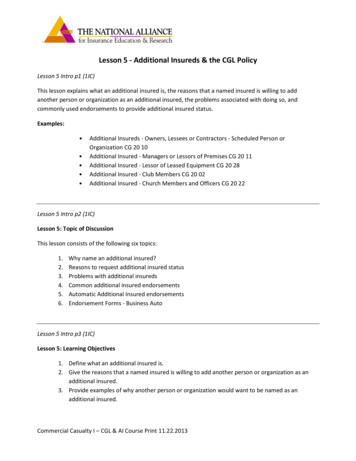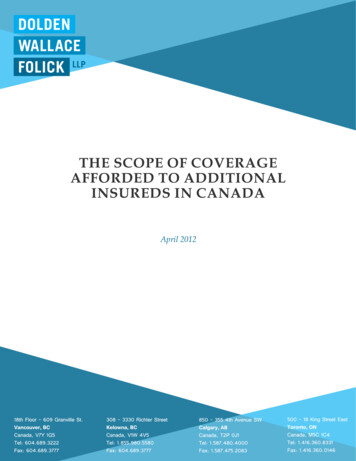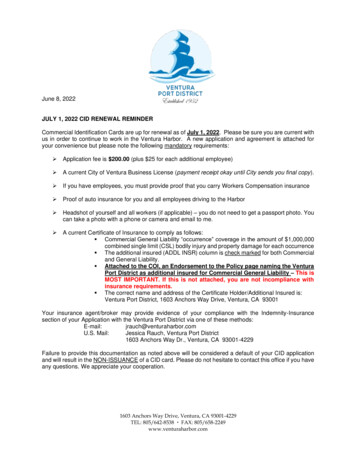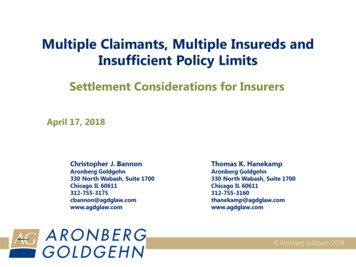
Transcription
Lesson 5 - Additional Insureds & the CGL PolicyLesson 5 Intro p1 (1IC)This lesson explains what an additional insured is, the reasons that a named insured is willing to addanother person or organization as an additional insured, the problems associated with doing so, andcommonly used endorsements to provide additional insured status.Examples: Additional Insureds - Owners, Lessees or Contractors - Scheduled Person orOrganization CG 20 10Additional Insured - Managers or Lessors of Premises CG 20 11Additional Insured - Lessor of Leased Equipment CG 20 28Additional Insured - Club Members CG 20 02Additional Insured - Church Members and Officers CG 20 22Lesson 5 Intro p2 (1IC)Lesson 5: Topic of DiscussionThis lesson consists of the following six topics:1.2.3.4.5.6.Why name an additional insured?Reasons to request additional insured statusProblems with additional insuredsCommon additional insured endorsementsAutomatic Additional Insured endorsementsEndorsement Forms - Business AutoLesson 5 Intro p3 (1IC)Lesson 5: Learning Objectives1. Define what an additional insured is.2. Give the reasons that a named insured is willing to add another person or organization as anadditional insured.3. Provide examples of why another person or organization would want to be named as anadditional insured.Commercial Casualty I – CGL & AI Course Print 11.22.2013142
4. Explain problems associated with additional insured status for both the named insured and theadditional insured.5. Explain the purpose and coverage provided for selected additional insured endorsements.6. Understand why an insured would benefit from an automatic additional insured endorsement.Forms Used In This Lesson:NoneCommercial Casualty I – CGL & AI Course Print 11.22.2013143
Lesson 5 Topic A - Why Name an Additional InsuredLesson 5 Topic A Why Name an Additional Insured p1 (1IC)Learning Objective: Define what an additional insured is.Definition of Additional InsuredAs we have seen in the CGL Policy, many liability policies provide insurance protection not only for thenamed insured but also for automatic insureds. These individuals or organizations are made an insured bythe Policy language. These parties are typically identified in the Who Is An Insured section of the Policy.Additional insured are those individuals or entities not normally provided insured status under the liabilitycoverage form but for which the named insured desires or is required to provide such coverage to thoseindividuals or entities.Lesson 5 Topic A Why Name an Additional Insured p2 (1IC)Define Additional InsuredLearning Objective: Define what an additional insured is.We are about to study additional insureds.Named InsuredsThis insured is any person or organization whose name appears on the Declarations of the insurance policy,who has the broadest coverage available on the policy, and who may be responsible for premium.Automatic InsuredsThis is an insured by virtue of language which already exists in the policy (Who Is An Insured section) such asemployees of the named insured or the named insured's real estate manager.Additional InsuredsThis refers to one or more persons or organizations other than the person or organization named on theDeclarations of an insurance policy who are also covered for certain losses under the policy. These insuredsare added by endorsement.Lesson 5 Topic A Why Name an Additional Insured p3 (1IC)Commercial Casualty I – CGL & AI Course Print 11.22.2013144
Why Name an Additional InsuredLearning Objective: Give the reasons that a named insured is willing to add another person ororganization as an additional insured.What creates the need to be named an additional insured; and, more importantly, why would the namedinsured want to add someone as an additional insured?There are two primary reasons. These are:1. A close relationship between the named insured and the person or organization.2. A contract requirement.Lesson 5 Topic A Why Name an Additional Insured p4 (1IC)Close RelationshipsLearning Objective: Give the reasons that a named insured is willing to add another person ororganization as an additional insured.It is common for your clients to want to add others as an additional insured on their policies because of aclose relationship.United ChurchUnited wants its clergy and church officers protected under the church's CGL Policy for liability arising fromperforming their church duties. The church also wants to extend liability coverage to its church members forliability arising out activities that the members perform on behalf of the church.American ClubAmerican has club members that perform activities on behalf of the club such as organizing club meetingsand charitable events sponsored by the club. American wants the club's CGL Policy to protect those clubmembers for liability that arise from performing those activities. American also wants to protect its clubmembers for liability, not just for the activities performed on their behalf, but also from liability that arisesfrom their members' participation in the club's activities, including social, service, recreational and sportsactivities.The Espanada CondominiumsEspanada wants its unit owners to be protected under the condominium association's CGL Policy for liabilityarising out of the ownership, maintenance or repair of the common areas of the condominium.Commercial Casualty I – CGL & AI Course Print 11.22.2013145
Lesson 5 Topic A Why Name an Additional Insured p5 (1IC)Contract RequirementLearning Objective: Give the reasons that a named insured is willing to add another person ororganization as an additional insured.It is common for individuals or entities to request additional insured status on your clients’ liability policiesfor business purposes.Lesson 5 Topic A Why Name an Additional Insured p6 (1IC)Contract Requirement continuedLearning Objective: Give the reasons that a named insured is willing to add another person ororganization as an additional insured.ABC Janitorial ServicesSilver Creek Retirement Center has contracted with ABC Janitorial Services to maintain its premises. Aspart of the contract, ABC is required to add Silver Creek as an additional insured on their CGL Policy. If ABCnegligently causes "bodily injury" or "property damage", Silver Creek wants to be covered by ABC's Policy.Tadd’s Floors 4 YouTadd is interested in providing carpet, tile and hardwood installation for Hillside Floor Coverings as anindependent contractor. Hillside Floor Coverings requires that it be added as an additional insured on eachindependent contractor's CGL Policy. If Tadd negligently causes "bodily injury" or "property damage" whileworking on behalf of Hillside, Hillside Floor Coverings wants to be covered by Tadd's Policy.Association of Cars of Years PastThe Association is hosting a car show at the local fairgrounds. The fairground requires the association to addit as an additional insured to its CGL Policy so that they will be covered by the Association's Policy in theevent of a "bodily injury" or "property damage" loss to a third party.Lesson 5 Topic A Why Name an Additional Insured p7 (1IC)Contract Requirement continuedLearning Objective: Give the reasons that a named insured is willing to add another person orCommercial Casualty I – CGL & AI Course Print 11.22.2013146
organization as an additional insured.The Ram RestaurantThe Ram leases its space from Rainier Properties, Inc. Rainier is requiring it beadded as an additional insuredto The Ram's CGL Policy so that it will be covered by The Ram's Policy in the event of a "bodily injury" or"property damage" loss.Meyers PrintingMeyers Printing leases a 500,000 press from AJK Industries. The lease agreement requires that AJK beadded to Meyers' CGL Policy as an additional insured so that AJK will be covered by Meyers Policy in theevent of "bodily injury" or "property damage" arising from the printing press.Easy ToolsEasy Tools is a tool manufacturer. Many of the large retail tool stores will not carry Easy Tools' productsunless Easy Tools names the retail stores as additional insureds on its CGL Policy.Lesson 5 Topic A Why Name an Additional Insured p8 (1IC)Contract requirement continuedLearning Objective: Give the reasons that a named insured is willing to add another person ororganization as an additional insured.In each of the previous examples, your client needed to add the other party as an additional insuredbecause of a business relationship.If your clients are unable or unwilling to provide the requested additional insured status, they may not begiven the work or the contract for the work. The Association will be unable to use the fairgrounds for thecar show. The restaurant may not get the lease it wants. The printer will not be able to lease neededequipment. The tool manufacturer loses important distribution outlets.You can see the importance of additional insureds as it impacts your clients’ business and businessdecisions.Commercial Casualty I – CGL & AI Course Print 11.22.2013147
Lesson 5 Topic B - The Reasons Behind Additional Insured RequestsLesson 5 Topic B Reasons to Request p1 (1IC)Learning Objective: Provide examples of why another person or organization would want to be named asan additional insured.What creates the need to be named an additional insured?While there are several reasons behind these requests, the primary reason is to provide additional insuredscoverage for losses for which they may be legally liable due to their business relationship with your client.They want to protect themselves from liability that arises out of your client's activities.The "upstream" party such as the building owner or business owner wants to be added as an additionalinsured on the policies of the "downstream" party such as the tenant, service provider, contractor, orsubcontractor.Service providers may be required to name customers as additional insureds while manufacturers,wholesalers and distributors may be required to named retailers as additional insureds.Lesson 5 Topic B Reasons to Request p2 (1IC)Reasons to Request continuedLearning Objective: Provide examples of why another person or organization would want to be named asan additional insured.Others may wish to be named an additional insured because:1.2.3.4.5.It may assure greater safety in a risk finance transfer.It creates the potential for the availability of higher limits of coverage.It can give them direct rights to your client's insurance.It may protect them from the potential risk of subrogation.It creates the potential to reduce the cost of their insurance.Lesson 5 Topic B Reasons to Request p3 (1IC)Reasons to Request continuedCommercial Casualty I – CGL & AI Course Print 11.22.2013148
Learning Objective: Provide examples of why another person or organization would want to be named asan additional insured.Requesting Additional Insured Status may assure greater safety in a risk finance transfer.In addition to the request for your client to hold the other party to the contract harmless, the contract mayalso require your client to name the other party as an additional insured to your client's CGL Policy.Why are both necessary?There are situations when the courts may find a hold harmless agreement unenforceable. This usually takesplace after the loss. As a result, the party that relied upon the hold harmless agreement to pay for a lossmay now need to use its own funds. This isn’t a desired outcome.By requiring additional insured status in conjunction with the hold harmless agreement, the other party canrely on your client’s insurance coverage as an additional insured if the hold harmless isn’t enforceable.Additional insured status for the other party assures it greater safety in a risk finance transfer – a “safetynet”, if you will, for the hold harmless agreement. They can seek direct coverage as an insured under yourclient’s insurance policy.Lesson 5 Topic B Reasons to Request p4 (1IC)Reasons to Request continuedLearning Objective: Provide examples of why another person or organization would want to be named asan additional insured.Example:In a contract with Clark Construction, your client agreed to hold the construction company harmless for anyloss arising out of his or her work for it.The hold harmless agreement requires your client to respond to certain legal liabilities for "bodily injury" or"property damage" that arise out of the client’s work for Clark. It is important to Clark that your client befinancially able to pay for losses that are part of the hold harmless agreement. Otherwise, Clark could finditself responsible for paying for a loss that it didn’t plan for.As an additional insured on your client’s CGL Policy, Clark knows that there is insurance in place (this is a riskfinance technique) and that, if needed, the Policy will provide coverage for them as well as your client. ClarkCommercial Casualty I – CGL & AI Course Print 11.22.2013149
Construction can present a claim as an indemnitee or as an insured.Lesson 5 Topic B Reasons to Request p5 (1IC)Reasons to Request continuedLearning Objective: Provide examples of why another person or organization would want to be named asan additional insured.2. Additional insured status can give another party direct rights to your client's insurance. As aninsured, additional insureds have direct rights to your clients’ CGL Policy.They can make their own direct claim under the Policy. If circumstances warrant it, they can alsosue the insurance company to obtain the court’s assistance in establishing their rights under thePolicy, including the right to a defense.Lesson 5 Topic B Reasons to Request p6 (1IC)Reasons to Request continuedLearning Objective: Provide examples of why another person or organization would want to be named asan additional insured.3. Additional insured status may protect the other party from the potential risk of subrogation.An insurance company cannot subrogate against the named insured after it pays a loss under theCGL Policy.As an insured under the Policy, the additional insured would enjoy this same benefit in mostjurisdictions; therefore, an additional insured would not be subject to subrogation.Example:Chef's Cuisine is one of the tenants renting space in a shopping center from Skylark Management Company.Chef added the Additional Insured Managers or Lessors of Premises (CG 20 11) endorsement to Chef's CGLPolicy naming the landlord as an additional insured.One of Chef's employees accidently started a fire in the restaurant kitchen. The building's fire suppressionsystem in the shopping center did not work properly so the fire was not contained immediately. The resultCommercial Casualty I – CGL & AI Course Print 11.22.2013150
was fire damage to Chef's restaurant and to an adjacent dress shop.Chef's insurance company paid the property damage claim to Chef and to the dress shop. Even thoughChef's employees started the fire, it was determined that Skylark was negligent in not properly maintainingthe fire suppression system. The insurance company cannot subrogate against Skylark because they are aninsured - an additional insured - on the Policy.Lesson 5 Topic B Reasons to Request p7 (1IC)Reasons to Request continuedLearning Objective: Provide examples of why another person or organization would want to be named asan additional insured.4. Additional insured status creates the potential for the availability of higher limits of coverage.Additional insureds may not only have access to the Limits Of Insurance on your client’s CGL Policyon a primary basis, but they may also have access to their own CGL Policy insurance limits on anexcess basis.This creates the potential that the additional insured may be able to stack the limits from bothpolicies in the event these higher limits are needed.Example:Burnson Construction is named as an additional insured on one of its sub-contractor’s CGL Policy.A large loss occurs and the limits on the sub-contractor’s Policy are not enough to pay the damages forwhich Burnson was found responsible.Burnson, after exhausting the limits available under its sub-contractor’s Policy, may have the limits on itsown CGL Policy available.Lesson 5 Topic B Reasons to Request p8 (1IC)Reasons to Request continuedLearning Objective: Provide examples of why another person or organization would want to be named asan additional insured.Commercial Casualty I – CGL & AI Course Print 11.22.2013151
5. Additional insured status creates the potential to reduce the cost of the additional insured'sinsurance.Since your client’s insurance policy is providing primary coverage to additional insureds, theadditional insureds’ own insurance may not be needed in the event of a loss.This results in better loss experience and possibly lower premiums for the additional insured’s owninsurance policy.From an underwriting standpoint, some insurance companies may require its named insured to benamed as an additional insured on the policies of others.It is also possible that named insureds requiring additional insured status on the policies of othersmay see a reduction in their cost of insurance as their insurance company recognizes primarycoverage will be provided elsewhere.Please complete the knowledge check found at Lesson 5 Topic B Reasons to Request p9 (1IC).Commercial Casualty I – CGL & AI Course Print 11.22.2013152
Lesson 5 Topic C - Potential ProblemsLesson 5 Topic C Potential Problems p1 (1IC)Learning Objective: Explain problems associated with additional insured status for both the namedinsured and the additional insured.We have just seen examples of situations that support the need for your clients to add additional insuredsto their CGL Policy.Before introducing and discussing various additional insured endorsements, it is important to understandhow additional insureds can create potential problems for both the named insured and the additionalinsured.The named insured may not have a choice in the matter; they must either add the additional insured or losethe contract or lease.Nevertheless, they should be made aware of the potential problems with adding additional insureds to theirinsurance policy. Likewise, if your clients are added to policies of others as an additional insured, theyshould know of the potential problems when relying on someone else’s insurance for protection.Lesson 5 Topic C Potential Problems p2 (1IC)Problems for the Named InsuredLearning Objective: Explain problems associated with additional insured status for both the namedinsured and the additional insured.1. Diminution of Policy LimitsThe number one problem for the named insured is the potential for diminution of policy limits.Regardless of the number of insureds (named, automatic or additional), there is only one "pot of money"per "occurrence". The more insureds, the more "fingers in the pot". Too many "fingers in thepot" increasesthe chances of the named insured having fewer dollars to pay damages for which it is held responsible.It makes sense that when more entities share the available limits, the limits may be used up more quicklywhen claims occur.2. Unintended Coverage Granted to the Additional InsuredCommercial Casualty I – CGL & AI Course Print 11.22.2013153
It is possible to provide unintended coverage for the additional insured.This does not usually happen on carefully constructed "standard" additional insured endorsements.However, some manuscript endorsements are so broad they provide unintended coverage.A manuscript endorsement is wording agreed to by the named insured and the insurance company when a"standard" endorsement is not available.3. Compliance ProblemsAdding additional insureds places administrative burdens on the named insured as well as the insuranceagency and its insurers.If your client does not meet the expectations of the additional insured, this could lead to complianceproblems.Example: If the policy is cancelled or if the named insured reduces the level of coverage on the policy, theadditional insured expects to be notified.Your client's administrative breakdowns may easily result in a breach of contract, which is not covered bythe named insured's insurance policy.Lesson 5 Topic C Potential Problems p3 (1IC)Problems for the Named Insured continuedLearning Objective: Explain problems associated with additional insured status for both the namedinsured and the additional insured.Diminishing Limits of InsuranceCraig’s Construction Company, Inc., does concrete work all over town and for different builders. As a result,six different entities have been added as additional insureds to Craig’s CGL Policy.A large liability loss occurs, and now three of the additional insureds are each looking at Craig's 1M limit ofliability on its CGL Policy.With four insureds, the Policy limits could quickly erode and potentially leave Craig's with an insufficientamount of coverage to pay for its claim.Unintended Coverage Provided to the Additional InsuredCommercial Casualty I – CGL & AI Course Print 11.22.2013154
Rod, Inc. is a large-scale contractor building a condominium.He is hiring all kinds of sub-contractors. His insurance company attached an endorsement to his CGL Policythat states any and all “subs” are additional insureds under certain situations.The wording is so inclusive that it could extend coverage to a subcontractor that Rod did not intend toinclude.Lesson 5 Topic C Potential Problems p4 (1IC)Problems for the Named Insured continuedLearning Objective: Explain problems associated with additional insured status for both the namedinsured and the additional insured.Compliance ProblemsTim’s Toys, LLC was required in a contract to name a major toy store as an additional insured before thestore would carry its products. The contract also required Tim's to carry 1M limits for bodily injury andproperty damage. Tim's provided the store with a certificate of insurance reflecting the 1M coverage andadditional insured status.Several months later and forgetting about the contractual requirement, Tim's changed its coverage to 500,000 in an effort to reduce expenses.A loss has now occurred, and the major toy store has just learned of Tim’s apparent breach of contractwhen it failed to comply with the contractual requirement to carry 1M liability coverage.Lesson 5 Topic C Potential Problems p5 (1IC)Problems for the Additional InsuredLearning Objective: Explain problems associated with additional insured status for both the namedinsured and the additional insured.1. May lose control of defense and investigationThe additional insured may lose control of his/her defense and investigation.Commercial Casualty I – CGL & AI Course Print 11.22.2013155
The insurance company, and not the additional insured, hires and directs the legal counsel.The insurance company may, at its discretion, investigate any occurrence and settle any claim or suit thatmay result.The insurance company does not have to have the permission of the additional insured before it can settle aclaim or lawsuit.2. "Other insurance" conflictsThere may be "Other Insurance" conflicts for the additional insured.Insurance policies include "Other Insurance" provisions, which state that a particular policy is primary orexcess and contributing or non-contributing when there is other insurance in force.Disputes between insurance companies over who pays first and how much can stall or limit claim payment.We'll look at this a little more closely in this section.3. Limited coverage for the additional insuredThere may be limited coverage under current forms.There have been significant changes made to additional insured endorsements over the years.Each edition date may change the coverage provided for the additional insured.4. Dependency on another party's InsuranceIt is not a good idea to depend on someone else's insurance.Limits, edition dates of the CGL Policy, exclusions and endorsements are outside of the additional insured'scontrol.Lesson 5 Topic C Potential Problems p6 (1IC)Problems for the Additional Insured continuedLearning Objective: Explain problems associated with additional insured status for both the namedinsured and the additional insured.Loss of Control Over Defense and InvestigationCommercial Casualty I – CGL & AI Course Print 11.22.2013156
Benum Construction was named as an additional insured on Charlie’s Construction’s CGL Policy.A claim was made against both Benum and Charlie’s by someone injured at the construction site. Benumtold Charlie’s insurance company that they are not at fault for the injuries; in fact, it was the injuredperson’s own fault. Benum does not want the insurance company to settle with the injured person becauseBenum's reputation would be ruined.Charlie’s insurance company, after investigating the loss, settles with the injured party.Lesson 5 Topic C Potential Problems p7 (1IC)Problems for the Additional Insured continuedLearning Objective: Explain problems associated with additional insured status for both the namedinsured and the additional insured.Other Insurance DisputesDisputes over the priority of coverage often arise when an entity purchases its own policy and alsointentionally obtains coverage as an additional insured on the CGL Policy of another.It is generally understood that the intent of this arrangement is that the entity's own CGL Policy, the CGL onwhich the entity is listed as a named insured, is to apply as excess and not share its limits with the CGLPolicy on which the entity is an additional insured.Example:The general contractor has his own CGL Policy and is also listed as an additional insured on the subcontractor’s CGL Policy.If both policies are the 2013 ISO CGL Coverage Form, the sub-contractor’s CGL Policy will provide primarycoverage for the general contractor. The general contractor will have excess coverage provided by his ownCGL Policy.Lesson 5 Topic C Potential Problems p8 (1IC)Problems for the Additional Insured continuedLearning Objective: Explain problems associated with additional insured status for both the namedCommercial Casualty I – CGL & AI Course Print 11.22.2013157
insured and the additional insured.More About Other Insurance DisputesThe April 2013 ISO CGL Coverage Form “other insurance” wording generally (with some notable exceptions)complies with this intent when the additional insured has been listed by endorsement to the other party’sCGL Policy.Problems can arise when the CGL Policy is an earlier edition date or the CGL Policy is an insurancecompany's proprietary form and not an ISO form. The “other insurance” language in either of these couldinclude very significant differences, which could take away primary coverage for an additional insured.It should also be noted that the “other insurance” language in the ISO CGL 2013 edition applies to additionalinsureds that have been added to the insurance policy of another.Additional insureds added to the policy of another will have primary coverage under that policy and excessunder their own CGL Policy.This wording does not provide the same coverage for “automatic insureds”. Automatic insureds, such as areal estate manager, could find themselves with two policies providing coverage on a primary basis.This will result in the policies sharing of limits, which might not have been the intent of either party.Lesson 5 Topic C Potential Problems p9 (1IC)Problems for the Additional Insured continuedLearning Objective: Explain problems associated with additional insured status for both the namedinsured and the additional insured.Example of Other Insurance DisputeBenum Construction was also named as an additional insured on the CGL Policy for Kitchens 4 You. Benumrequired and understood Kitchens’ Policy to provide liability coverage on a primary, non-contributory basis.A loss occurs at which time Benum discovers Kitchens' CGL Policy states that coverage available to anyadditional insured applies only as excess to any insurance purchased by the additional insured.While Benum expected Kitchens’ Policy to pay on a primary basis, it is now looking to its own insurancepolicy for primary coverage.Commercial Casualty I – CGL & AI Course Print 11.22.2013158
Lesson 5 Topic C Potential Problems p10 (1IC)CG 20 10 Endorsement Form Edition DatesLearning Objective: Explain problems associated with additional insured status for both the namedinsured and the additional insured.Limited Coverage for Additional InsuredAs we will discuss shortly, the 11/85 edition of the CG 20 10 included additional insured status for liabilityarising out of the insured’s work while the 04/13 edition provides coverage for liability caused in whole or inpart by the named insured’s acts or omissions or those acting on behalf of the named insured.In other words, the latest edition requires at least partial responsibility for the damages to be the namedinsured’s or those working on behalf of the named insured. This does not provide coverage if the loss issolely caused by the additional insured.The 11/85 edition also provided coverage for liability arising out of the named insured’s work, whichincluded Completed Operations. Subsequent editions provide coverage caused in whole or in part by theongoing operations for the Additional Insured of the named insured. Ongoing operations does not includecompleted operations.You can see the importance of knowing the edition date of the additional insured endorsement being used.Lesson 5 Topic C Potential Problems p11 (1IC)Problems for the Additional Insured continuedLearning Objective: Explain problems associated with additional insured status for both the namedinsured and the additional insured.Dependency on Another Person's Or Entity's InsuranceHow does the additional insured know that the policy is still in effect, the required limits still carried, theedition date of the CGL Policy, and the endorsements or exclusions that apply?These factors are outside of the direct control of the additional insured; yet they potentially impa
This lesson explains what an additional insured is, the reasons that a named insured is willing to add another person or organization as an additional insured, the problems associated with doing so, and . Endorsement Forms - Business Auto . Lesson 5 Intro p3 (1IC) Lesson 5: Learning Objectives . 1. Define what an additional insured is.










